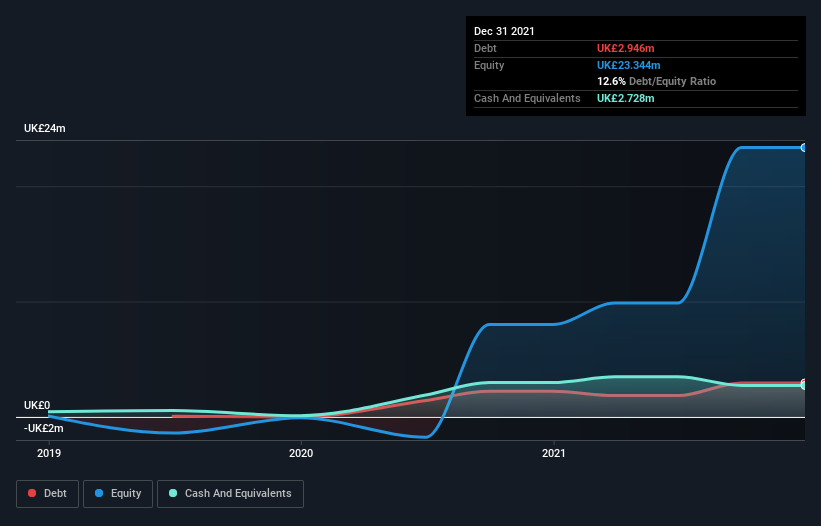The external fund manager backed by Berkshire Hathaway's Charlie Munger, Li Lu, makes no bones about it when he says 'The biggest investment risk is not the volatility of prices, but whether you will suffer a permanent loss of capital.' It's only natural to consider a company's balance sheet when you examine how risky it is, since debt is often involved when a business collapses. We note that eEnergy Group Plc (LON:EAAS) does have debt on its balance sheet. But should shareholders be worried about its use of debt?
When Is Debt A Problem?
Debt assists a business until the business has trouble paying it off, either with new capital or with free cash flow. Part and parcel of capitalism is the process of 'creative destruction' where failed businesses are mercilessly liquidated by their bankers. However, a more frequent (but still costly) occurrence is where a company must issue shares at bargain-basement prices, permanently diluting shareholders, just to shore up its balance sheet. Of course, plenty of companies use debt to fund growth, without any negative consequences. The first step when considering a company's debt levels is to consider its cash and debt together.
See our latest analysis for eEnergy Group
How Much Debt Does eEnergy Group Carry?
The image below, which you can click on for greater detail, shows that at December 2021 eEnergy Group had debt of UK£2.95m, up from UK£2.22m in one year. However, it does have UK£2.73m in cash offsetting this, leading to net debt of about UK£218.0k.

How Strong Is eEnergy Group's Balance Sheet?
The latest balance sheet data shows that eEnergy Group had liabilities of UK£15.2m due within a year, and liabilities of UK£4.62m falling due after that. Offsetting these obligations, it had cash of UK£2.73m as well as receivables valued at UK£8.05m due within 12 months. So it has liabilities totalling UK£9.03m more than its cash and near-term receivables, combined.
This deficit isn't so bad because eEnergy Group is worth UK£40.2m, and thus could probably raise enough capital to shore up its balance sheet, if the need arose. However, it is still worthwhile taking a close look at its ability to pay off debt. But either way, eEnergy Group has virtually no net debt, so it's fair to say it does not have a heavy debt load!
We use two main ratios to inform us about debt levels relative to earnings. The first is net debt divided by earnings before interest, tax, depreciation, and amortization (EBITDA), while the second is how many times its earnings before interest and tax (EBIT) covers its interest expense (or its interest cover, for short). Thus we consider debt relative to earnings both with and without depreciation and amortization expenses.
eEnergy Group has a very low debt to EBITDA ratio of 0.25 so it is strange to see weak interest coverage, with last year's EBIT being only 0.91 times the interest expense. So while we're not necessarily alarmed we think that its debt is far from trivial. We also note that eEnergy Group improved its EBIT from a last year's loss to a positive UK£386k. The balance sheet is clearly the area to focus on when you are analysing debt. But ultimately the future profitability of the business will decide if eEnergy Group can strengthen its balance sheet over time. So if you want to see what the professionals think, you might find this free report on analyst profit forecasts to be interesting.
Finally, a business needs free cash flow to pay off debt; accounting profits just don't cut it. So it's worth checking how much of the earnings before interest and tax (EBIT) is backed by free cash flow. Over the last year, eEnergy Group saw substantial negative free cash flow, in total. While that may be a result of expenditure for growth, it does make the debt far more risky.
Our View
Both eEnergy Group's conversion of EBIT to free cash flow and its interest cover were discouraging. But at least its net debt to EBITDA is a gleaming silver lining to those clouds. Taking the abovementioned factors together we do think eEnergy Group's debt poses some risks to the business. While that debt can boost returns, we think the company has enough leverage now. When analysing debt levels, the balance sheet is the obvious place to start. However, not all investment risk resides within the balance sheet - far from it. These risks can be hard to spot. Every company has them, and we've spotted 4 warning signs for eEnergy Group you should know about.
If you're interested in investing in businesses that can grow profits without the burden of debt, then check out this free list of growing businesses that have net cash on the balance sheet.
New: Manage All Your Stock Portfolios in One Place
We've created the ultimate portfolio companion for stock investors, and it's free.
• Connect an unlimited number of Portfolios and see your total in one currency
• Be alerted to new Warning Signs or Risks via email or mobile
• Track the Fair Value of your stocks
Have feedback on this article? Concerned about the content? Get in touch with us directly. Alternatively, email editorial-team (at) simplywallst.com.
This article by Simply Wall St is general in nature. We provide commentary based on historical data and analyst forecasts only using an unbiased methodology and our articles are not intended to be financial advice. It does not constitute a recommendation to buy or sell any stock, and does not take account of your objectives, or your financial situation. We aim to bring you long-term focused analysis driven by fundamental data. Note that our analysis may not factor in the latest price-sensitive company announcements or qualitative material. Simply Wall St has no position in any stocks mentioned.
About AIM:EAAS
eEnergy Group
Operates as a digital energy services company in the United Kingdom and Ireland.
Excellent balance sheet with reasonable growth potential.
Market Insights
Community Narratives




